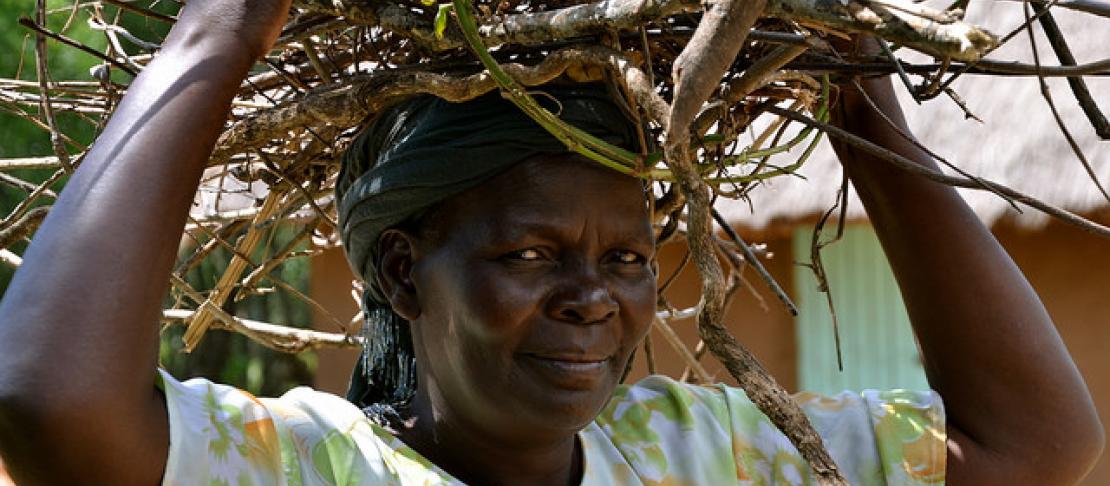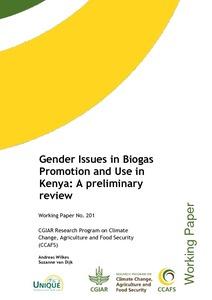Gender and energy: Can biogas production help Kenyan women meet their energy needs?

Biogas production and use could help Kenyans meet their growing energy needs while also reducing the burden of wood collection on women and girls. Biogas adoption, however, remains limited.
Could biogas production, a renewable energy created through the anaerobic breakdown of organic matter, help Kenyan women meet their energy needs? Is it a cost-effective way to reduce greenhouse gases? A recent review of the current literature and available data, conducted by the Kenya dairy Nationally Appropriate Mitigation Action (NAMA), with support from the CGIAR Research Program on Climate Change, Agriculture and Food Security (CCAFS), aims to understand biogas adoption patterns amongst women and men.
Energy needs are a growing concern in Kenya. Seventy-five percent of rural households depend on wood as an energy source. For women and girls, this reliance on wood translates into high labor and energy demands and increased health costs.
The responsibility to collect firewood often falls on girls, leading to lower rates of school enrollment for school-aged girls. In comparison with male-headed households, women household heads are more likely to be worried about the health risks associated with domestic energy use. However, despite unequal, gender-based energy burdens, men are more likely to have access to income and credit facilities. Men, therefore, are more likely to make energy decisions, like whether or not to adopt solar or electric power.

Biogas use could dramatically improve women's health as it limits their exposure to indoor smoke. Photo: M. Acosta (IITA)
Increased biogas use at the farm level could yield a number of positive benefits. Moving away from wood-based energy sources will help to mitigate climate change, reduce energy costs and demands on natural resources, decrease the time and energy women and girls spend collecting wood, and lessen exposure to indoor smoke. Biogas slurry can also be used as a fertilizer, with the potential to increase agriculture yields or, if sold, serve as another source of household income. For Kenyan small-scale farmers, biogas production is an important step in the utilization of interrelated resources, which maximizes food and energy production and improves efficiency.
Despite the benefits of biogas, adoption patterns remain low. Reports that examine the availability of livestock waste and water availability indicate the potential for biogas adoption is between 320,000 to 1.26 million households in Kenya. The number of installed units, however, is estimated to be between 4,000-16,000 units as of 2014.
Gender Issues in Biogas Promotion and Use in Kenya: A preliminary review
Wilkes and van Dijk (2017) offer a literature review, identifying a number of constraining factors for biogas innovation diffusion in Kenya, including limited information, high initial costs, and a lack of regulatory standards. The characteristics of biogas product designs can also limit adoption. For instance, potential users may avoid designs that require excessive repairs or have parts that are prone to breaking. Women may avoid biogas digesters due to the need for increased water collection. While some studies suggest the characteristics of household decision makers - including age, gender, and educational attainment – plays a role in innovation adoption, the results are not consistent. While gender dynamics are an important consideration for adoption, research on the topic remains limited.
Men are also more likely to own land, which is a major factor in obtaining credit, and access to information about innovations, increasing their likelihood of adopting new technologies. There are also gendered considerations for the use and maintenance of biogas units. While men are more likely to be involved in the decision to adopt biogas technologies, taking care of the unit once it’s purchased often falls to women.The gender of household heads is often the basis for understanding gender differences; few studies examine inter-household, gender-based decision making on use of biogas. Acknowledging the need for further research, this review does make note of the few studies that do examine the role of gender in biogas adoption. For instance, while men are often the main decision-makers, the gendered differences associated with energy procurement and use means that men and women may have different energy priorities, especially in regards to health.
Despite the barriers and concerns associated with gender and biogas adoption and use, there are avenues to mainstream gender in biogas promotion strategies. For example, biogas stoves could be designed with the needs of women in mind, convenient training times and locations should be offered, and the link between biogas activities and entrepreneurship should be emphasized.
The adoption of new innovations is often a slow process. Highlighting the benefits of biogas adoption, while acknowledging the limitations and gender constraints associated with the technology, will help rural households make the best decision about how to meet their energy needs.
Download the working paper: Wilkes A, van Dijk S. 2017. Gender Issues in Biogas Promotion and Use in Kenya: A preliminary review. CCAFS Working Paper no. 201. Wageningen, the Netherlands: CGIAR Research Program on Climate Change, Agriculture and Food Security (CCAFS).
Kathlee Freeman is a communications consultant with the CGIAR Research Program on Climate Change, Agriculture and Food Security (CCAFS).




